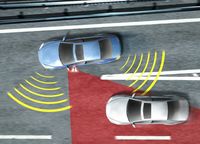Side View Assist, The Blind-Spot Assistant
EDITORS NOTE: A couple of month's ago I tested a 2010 Mazda CX-9 (I loved it!, luxurious, spacious and easy to handle and drive.) equipped with Side View Assist, it was my first vehicle with it and boy was I was impressed. Driving on California's freeways was made more civilized because of it. in fact I will make sure that my next car purchase includes Side View Assist.
DENHAM, UNITEDKINGDOM – October 29, 2010: Nearly all popular passenger cars are aerodynamically shaped. However, what is gained in visual appeal and eco-friendliness is often lost in all-round vision. That very often results in critical situations, particularly when drivers are changing lanes. The Bosch ‘Side View Assist’ blind-spot assistant is an innovative driver assistance system that helps drivers when they are changing lanes and warns them of dangers. Like the Bosch parking aid and parking assistant, the system uses ultrasonic sensors. Because of the combination of several ultrasound-based features, and because the Side View Assist makes use of electronic components already present in the car, the system offers automakers – and thus ultimately car buyers – significant cost savings compared with radar- or video-based systems.
The Side View Assist system is capable of registering objects three metres to the side and diagonally to the rear of the vehicle, which means that it covers precisely those areas that are located in the dangerous “blind spot” area. If the sensors detect a vehicle, their signal is first checked for plausibility by the system's electronics to prevent false alarms. The Side View Assist system can then warn the driver in two ways: first optically, and then, if the driver fails to react, acoustically.
The Side View Assist system's ultrasonic sensors are mounted in the sides of the vehicle's front and rear bumpers. The two rear-side sensors monitor the blind spot on the lanes to the right and left. The two front sensors are used exclusively for plausibility checks. If, for example, the front left sensor detects an object before the rear left sensor does, it is clear that an oncoming vehicle on the other side of the road is driving by the vehicle in question, and the electronic sensors do not warn the driver. The sensors use the same technique to detect parked vehicles, road signs and to register when drivers are passing other cars. In those cases, they do not set off an alarm. It is only when one of the rear side sensors reports an object that has not already been detected by the front sensors that danger is imminent. The Side View Assist then warns the driver optically by activating a light signal in the side mirror on the same side on which the object was detected. If the driver misses or ignores this warning and uses the turn signal to indicate a lane change, the Side View Assist can activate an additional audible warning signal.
The Side View Assist system works at speeds of between 10 and 140kph. Outside that range, it does not warn drivers. The system aids drivers in complex traffic situations when relative speeds are low, and therefore mostly helps them on urban roads and highways and on multi-lane roads where speed limits are in place. The system warns drivers but does not intervene directly in their actions.
The Bosch Side View Assist system is an important contribution to road safety. Accident statistics show that the majority of lane-changing accidents happen at speeds of under 100kph. Of those accidents, the majority occur at speeds of 60kph or less.
Bosch began developing ultrasonic sensors for automobiles as early as 1989. Since production began in 1993, Bosch has produced far more than 100 million ultrasonic sensors, making it the market leader. Initially, ultrasonic sensors were used only as simple proximity warning devices to prevent drivers from denting their cars in parking lots. By 2006 the technology had matured enough for the first parking assistant to be used. It was able to measure the exact length of parking spaces. With the aid of electric power steering, the Bosch parking assistant has been performing all the necessary steering movements for drivers precisely and automatically since 2008, making sure that vehicles manoeuvre perfectly into their parking spots.
Bosh operates ultra-modern production plants at three sites in Europe, Asia, and North America to produce its ultrasonic sensors and their control units.



